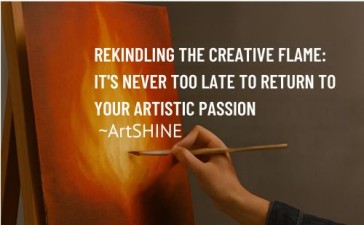This simple truth reveals what many self-proclaimed “perfectionists” don’t want to acknowledge: their endless pursuit of flawlessness isn’t always about excellence—it’s frequently about avoidance.
The Badge of Honor That Holds You Back
“I’m a perfectionist,” they announce with a hint of pride in their voice. As if revealing a secret superpower rather than admitting a limitation. They speak of their exacting standards, their commitment to quality, their unwillingness to settle for mediocrity. And yet, their portfolio remains mysteriously thin. Their canvas stays blank. Their creative output exists primarily in the realm of “someday.”
What many creatives fail to recognize is that perfectionism, far from being a mark of superior craftsmanship, often serves as an elaborate defense mechanism against the vulnerability of actually creating something and putting it into the world.
The Perfectionism Paradox
True masters of their craft understand a fundamental paradox: perfection is achieved not through endless planning and hesitation but through iteration, failure, and growth. The acclaimed author James Clear puts it succinctly: “The only way to become excellent is to be endlessly fascinated by doing the same thing over and over. You have to fall in love with boredom.”
This stands in stark contrast to the perfectionist’s approach. They don’t fall in love with the process—they become infatuated with an imaginary outcome that forever remains just out of reach.
Behind the Perfectionist Facade
What drives this behavior? At its core, perfectionism-as–
1. Fear of judgment: By never completing work, you never have to face criticism.
2. Fear of disappointment: If the final product doesn’t match your vision, the disappointment might be crushing.
3. Fear of revealing limitations: Finished work might expose the gap between your taste and your current abilities.
4. Fear of identity loss: If perfection is part of your identity, what happens when you produce something imperfect?
Study: The Novelist Who Never Wrote
Consider Thomas, a creative writing professor who spoke eloquently about narrative structure, character development, and the nuances of voice. For fifteen years, he talked about the novel he was perfecting. He had elaborate systems of notes, character sketches spanning dozens of pages, and detailed outlines that he perpetually revised.
What he didn’t have was a completed manuscript.
When pressed by colleagues about publication plans, Thomas would explain that his work “wasn’t quite ready yet.” He needed to research one more historical detail, refine one more plot point, reconsider one more character motivation. His standards, he reminded everyone, were exceptionally high.
The painful truth emerged during a department workshop when a junior colleague challenged him: “What if your perfectionism is really just fear wearing a sophisticated disguise?”
The question hit home. In therapy, Thomas later acknowledged that his father’s relentless criticism during childhood had created a paralyzing fear of judgment. His “perfectionism” was actually a shield protecting him from potential criticism—if he never finished the book, it could never be rejected or panned by critics.
Once he recognized this pattern, Thomas set modest daily writing goals with no editing allowed during first drafts. He finished his novel within a year. It wasn’t perfect—no first published novel is—but it was real, and it opened the door to actual growth rather than theoretical perfection.
Case Study: The Designer’s Empty Portfolio
Eliza graduated top of her class from a prestigious design school. Her professors noted her exceptional eye for detail and composition. Yet three years after graduation, her professional portfolio contained only student work and a handful of small projects.
When potential clients approached her, Eliza would often begin projects enthusiastically but struggle to complete them. She would create dozens of concepts but find reasons why each wasn’t quite right. She would obsess over minute details that clients couldn’t even perceive.
“I’m known for my perfectionism,” she would explain when deadlines slipped. “I won’t deliver work I’m not completely satisfied with.”
The turning point came when a mentor reviewed her process and observed: “You’re not a perfectionist, Eliza. You’re afraid of being definitive.” This insight led to a difficult realization—Eliza wasn’t pursuing excellence; she was avoiding the moment when her work would be judged. As long as projects remained “in progress,” they remained safe from criticism.
Her mentor implemented a new system: for every project, they defined three clear criteria for success. Once those criteria were met, the project was declared complete—no exceptions. Six months later, Eliza had a robust portfolio and had doubled her client base.
Breaking the Perfectionism Cycle
If you recognize yourself in these patterns, consider these steps to move from perfectionism-as-
1. Set clear completion criteria before starting: Define what “done” looks like before beginning a project.
2. Embrace “good enough for now: Remember that iteration after feedback leads to better results than endless pre-feedback polishing.
3. Create artificial deadlines: Even if no one is waiting for your work, set and honor submission deadlines.
4. Practice finishing: Complete small, low-stakes projects regularly to build your “finishing muscle.”
5. Separate creation from evaluation: Create freely in one session, then wear your critic’s hat in another.
6. Change your language: Replace “I’m a perfectionist” with “I’m practicing completion.”
The Freedom of Imperfection
The most prolific and ultimately successful creatives understand that creation is messy. They produce work regularly, learn from what doesn’t work, and continuously improve through the cycle of completion and feedback.
Ira Glass, the renowned radio producer, describes “the gap”—that painful space between your excellent taste and your current abilities. The only way to close this gap is to create volume, to finish pieces, to get feedback, and to apply what you learn to the next creation.
Perfectionism keeps you trapped in an endless loop of planning and preparing. It promises protection from criticism but delivers only creative stagnation.
The next time you find yourself polishing the same piece endlessly or planning rather than producing, ask yourself: “Is my perfectionism serving my creative growth, or is it simply procrastination wearing sophisticated clothes?”
Then put down your plans, pick up your tools, and make something. Make it as well as you can today, knowing that “as well as you can” will be better tomorrow only if you complete something today.
Because in the end, a flawed creation in the world will always teach you more than the perfect creation that exists only in your mind.
“Make tomorrow Today” ~Vinh Van Lam
💥 Want to learn more?
Find out more:
👉 Launch Pad + Accelerator Expressions of Interest
👉 Selling and Licensing Your Art & Designs Around the World with ArtSHINE
We’re here to help you take action—just like we’ve helped thousands of entrepreneurs, business owners, and creative professionals around the globe.
✨ Want regular inspiration, mindset tips, and art licensing opportunities sent straight to your inbox?
Sign up for the ArtSHINE Weekly Newsletter and stay connected to a creative community that’s growing, thriving, and shining together.
Now is the time to let your passion SHINE.
Now is the time to Make Tomorrow Today!
To your success,
Vinh Van Lam & Stuart Horrex
Cofounders, ArtSHINE.com
Professional Creative Transition Coach
Helping accomplished professionals rediscover their creative potential





